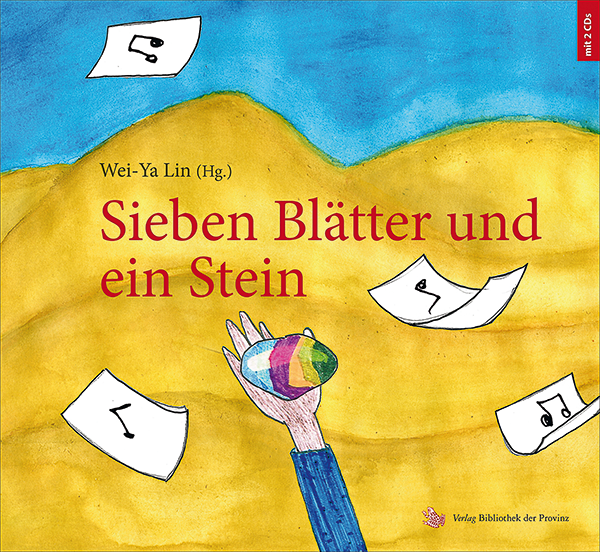Sieben Blätter und ein Stein: Das Märchen von Märchen. Wei-Ya Lin (ed.) published by Verlag Bibliothek der Provinz, 2017. 81 pages. 2 CDs (audio book + music)

A picture and audio book for children and adults? An unusual product of research? Or a collection of musical travel documents? Wei-Ya Lin’s Sieben Blätter und ein Stein [Seven Pieces of Paper and a Stone] is difficult to attribute to a single publication platform or even to recommend to a certain audience. This book attempts something that amounts to a huge stretch—and succeeds. What we have before us would appear to be some sort of literary-scholarly-ethnomusicological-visual mixture, and upon further reflection, this reviewer finds that it was in fact almost mandatory that a commensurately hybrid format be chosen for the subject matter at hand.
The subject matter is transculturality, or to be more precise: the living environments and musical worlds of children and adolescents with migratory backgrounds in Vienna’s third district. Together with students of the Kleistgasse primary school and the “new intermediate school” on Kölblgasse, Wei-Ya Lin and Hande Saglam conducted a participative research project in which young people dealt with the musics of the families from which they come. These musics were given a close look together with instrumental music education students and then worked with in a wide variety of ways. One of the things that these kinds of participative research formats always try to do is to search for new ways of presenting their results that draw on, address, and actively involve all participants.
The (audio) book: one of these outcomes is a book in which—as Wei-Ya Lin explains in her afterword—“every student … [had the opportunity] to be one of the seven main characters in the story Sieben Blätter und ein Stein”. Its plot is situated in close proximity to Michael Ende’s fantastical coming-of-age novel The Neverending Story (in which Bastian Balthasar Bux, alternating between school and his fantasy world, grows more mature—as do the seven main characters in the present story). It is also a book that draws on all manner of fairy tale sources for its material (hence the subtitle Das Märchen von Märchen [The Fairy Tale of the Fairy Tale]), which moulds the children’s mother tongues from back home—in the manner of Harry Potter—into magic words capable of destroying evil dragons, and which is illustrated with drawings by the children who participated. Last but not least, this book comes with its own audio book version, as well as with sheet music for all of the included pieces of music, background information, and other things for its readers to ponder.
The music: I would call the included music the greatest treasure to be found in Sieben Blätter und ein Stein. Anyone who has children will certainly value these pieces from the Balkans and from the Arab world, which have been rendered with enormous musical and ethnomusicological care. It is quite rare to find such precision in books for children and adolescents, and these pieces of music are capable of opening our ears to the native and transculturally mixed musics of young Viennese people.

